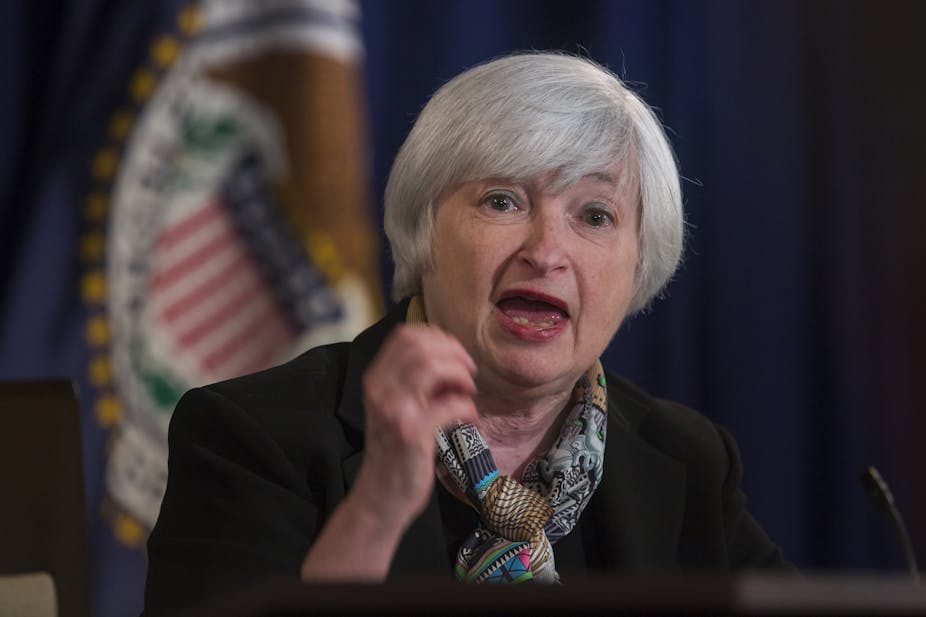The US Federal Reserve this week has moved one step closer to lifting interest rates by ending its controversial bond-buying program. This begins a long-anticipated process that will take many months to complete: the metamorphosis of a dove into a hawk.
This leaves us with the question of a date for an actual rate hike – a moment economists expect surveyed by CNBC expect will be in July 2015, a month later than previously forecast.
The central bank has championed this period of ultra-easy money with its unprecedented asset purchases and near-zero interest rate policy in hopes of boosting inflation and spurring employment. It’s what in economic parlance is known as acting dovish.
Now that the jobless rate has dropped below 6% for the first time since 2008, the Fed is set to begin what will almost certainly be a messy transition to a more hawkish monetary policy as it prepares to raise its target rate.
The Fed on Wednesday said it would end the final US$15 billion in bonds it has been purchasing every month – which has contributed to its swollen balance sheet of more than US$4 trillion.
Markets have already come to terms with the end of QE and priced in their reaction and of course did not expect a change in interest rates. The committee members feel that there is still enough slack in the labour market. This, combined with the current geo-political uncertainties, seems enough of a justification to not change the Fed rate.
Market reaction
This brings us to the more interesting question of how markets will react when the actual increase occurs and by how much. Between now and then, market commentators will inspect every word in every statement to decipher when the Fed will decide to move. This is a rather useless exercise, as they themselves don’t have a clue.
Central banks like things to take place gradually, especially when it comes to rates going up. The only reason to go for big increases is when markets lose faith in your currency.
Have you noticed how all the talk about the US dollar losing its dominance has disappeared? With China’s economy revealing more and more unsavoury cracks, Japan lingering on and the Eurozone in permanent crisis, US dollar dominance has not looked this strong since the eighties.
Indeed it has gained almost 8% just since this summer, according to Forbes. So we know that we are talking about a quarter percentage point increase.
So is such a small change worth thinking about? The answer is a resounding yes. To get some clues as to what might happen, just look at the tapering effect.
In May of last year, the Fed first indicated it would begin tapering its bond buying program in the near future, and all hell broke loose. So this happened when only the prospect of a small change in QE was announced. The reason of course is that the major central banks have flooded the world with almost free money for years now. Investors awash with all this money pumped it into anything that might give it a decent return, however risky it might be.
A beauty contest
It’s hardly surprising then that news that the tap will be slightly closed (indicating that rates are set to rise), panicked investors knowing that they were making profits by betting on frothy markets. Investments are judged by how much profits are better than the Fed rate. It is as Keynes said, like a beauty contest.
Who will look the ugliest? The best thing is to take a clue from the tapering episode. According to the IMF, Brazil, India, Indonesia, Turkey, and South Africa, saw, on average, bond yields rise by 21 to 22 percentage points, equity market fall by nearly 14%, exchange rates depreciate by 13.5% while reserves declined by 4.1% during May 22–(end of) August. On average, currencies across emerging markets (21 countries in sample) depreciated 3%, spreads rose 1 percentage point and equities fell 7%.
Yes, those countries who will find it more difficult to cope will be the hardest hit. Will it be worse when the rate rise hits or will the reaction be milder. Let me use the economist’s favourite sentence, it depends.
How surprised will markets be? How much of a change in future policy will they expect? How prepared will the emerging countries be? Both Indonesia and India for example have elected reform-minded governments, Brazil decided not to. I’ll be honest, your guess is as good as mine. I wish they would have closed the tap, before so many of us got wet feet.

